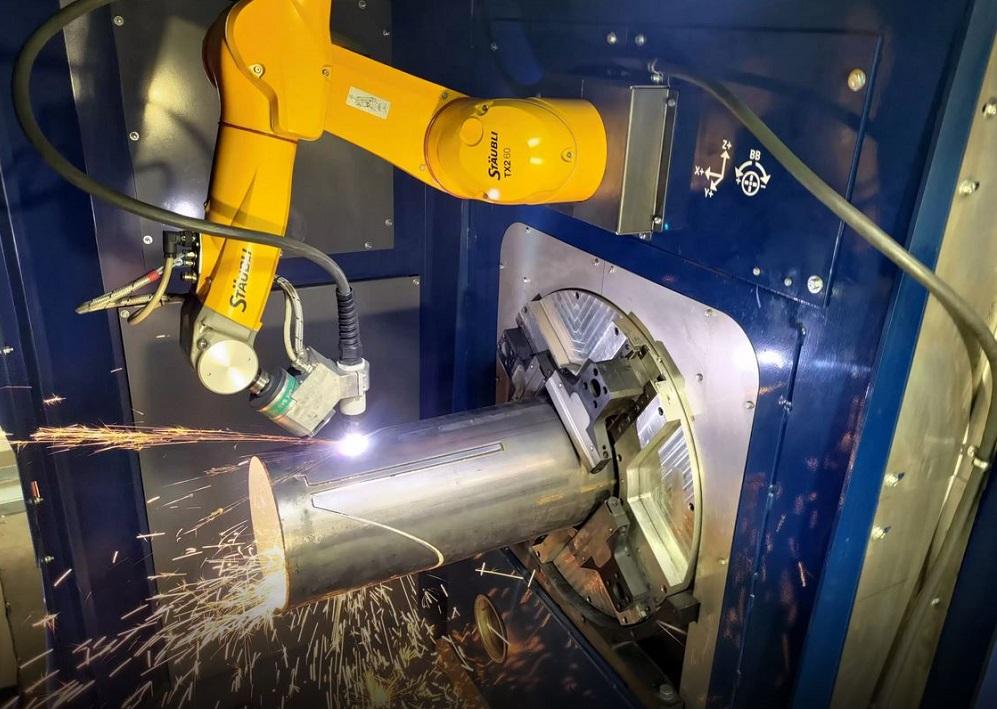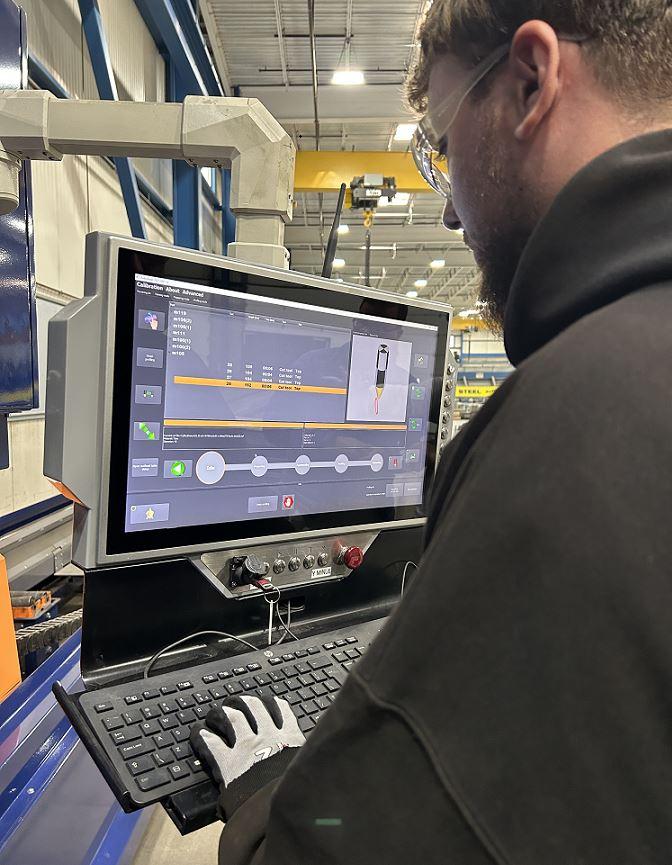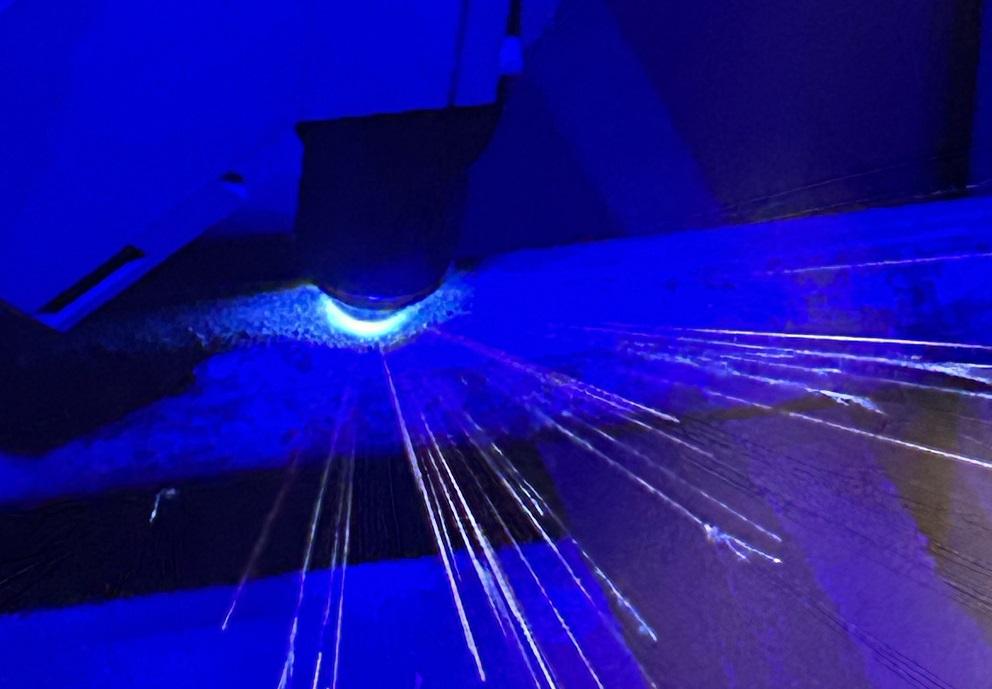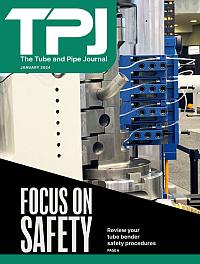Editorial Writer
- FMA
- The Fabricator
- FABTECH
- Canadian Metalworking
Categories
- Additive Manufacturing
- Aluminum Welding
- Arc Welding
- Assembly and Joining
- Automation and Robotics
- Bending and Forming
- Consumables
- Cutting and Weld Prep
- Electric Vehicles
- En Español
- Finishing
- Hydroforming
- Laser Cutting
- Laser Welding
- Machining
- Manufacturing Software
- Materials Handling
- Metals/Materials
- Oxyfuel Cutting
- Plasma Cutting
- Power Tools
- Punching and Other Holemaking
- Roll Forming
- Safety
- Sawing
- Shearing
- Shop Management
- Testing and Measuring
- Tube and Pipe Fabrication
- Tube and Pipe Production
- Waterjet Cutting
Industry Directory
Webcasts
Podcasts
FAB 40
Advertise
Subscribe
Account Login
Search
Improving fabrication versatility through automation
Nimble plasma cutter fits the bill for structural tube fab shop
- By Mary Ellen Klukow
- February 8, 2024
- Article
- Tube and Pipe Fabrication

Whether it's tubes, larger pipes, or specialty shapes, SL Chasse's RoboRail machine is designed to be versatile enough to handle them all easily.
For SL Chasse Steel (SLCS), a fabricator in Hudson, N.H., the business has always been about delivering timely, quality parts for two very different groups of customers.
The company, founded by Steve Chasse in 1989, specializes in fabricating structural steel and miscellaneous metals. Chasse started the company alone; today, it employs 180 people who mainly manufacture, assemble, and erect items like I-beams and catwalks. Customers include contractors, owners, and developers.
Years ago, SLCS divided its manufacturing space into two shops: an 80,000-sq.-ft. structural steel shop and a 20,000 sq.-ft. shop for miscellaneous metals. The structural shop handles all steel components used in a project’s underlying structural support. That business has proven straightforward enough. However, Chasse turned a critical eye toward his miscellaneous shop because of how prone it was to slow production.
The miscellaneous shop handles steel components like stair assemblies and railings. Because that business involves more intricate parts, the work tends to be done manually. “It’s slow,” Chasse said. “We were measuring and laying out a lot of things by hand.”
Unfortunately, with the precision demands of the miscellaneous shop’s parts, production was getting backlogged. Once upon a time, after marking out cuts with soapstone, shop operators used plasma machines, saws, coping machines, and punch presses to get the right cut.
“We had to bounce from one machine to the next to the next to get the end product,” Chasse recalled. “It was very time-consuming.”
RoboRail Gets on Track
Chasse wanted something more versatile—something durable that could process a wider range of shapes than his former setup. He reached out to HGG Profiling Equipment in Houston, a maker of 3D profiling machines for cutting exact forms on pipes, beams, and other steel profiles.
The two companies began collaborating on an automated unit that was agile enough to process handrail pipes, stringer channels, hollow structural section tubes, angle iron—anything that might come through the miscellaneous shop.
The machine they created, the RoboRail, was designed with a small footprint and a sturdy base, enabling it to handle material up to 40 ft. long and 1,100 lbs. without taking up a lot of room. The all-in-one robotic machine automates plasma cutting, holemaking, marking, and coping. It can also handle many different material types and shapes.
In addition, the RoboRail’s software can convert almost any CAD file into workable data and begin planning its cuts. For SLCS, the automatic pipe profiling reduces the process layout, marking, and cutting from several minutes to 30 seconds. Most important, once a part comes off the RoboRail, its profiles are already accurate enough for immediate welding.

Learning to operate the RoboRail system has proven easy for SL Chasse employees, who have generally been able to get trained in two days.
“The precision of the parts that come off the RoboRail is typically spot on, no need for clean-up. They are ready to go into any assembly that is being fabricated,” Chasse said.
SLCS was one of the very first manufacturers to install a RoboRail unit, so Chasse was braced for a steep learning curve and an unpredictable introductory period. He was pleasantly surprised.
“We were able to train our people in two days,” he said. The shop currently has four or five employees who can run the machine, and Chasse is looking forward to training more. In this instance, the notion that automation runs people out of jobs is just a myth, he said. The company is currently bringing on more employees and retraining current ones for fabricating roles as its new automated system creates more work on that end of the production line.
As for the quality of the parts, “they’re outstanding,” said Chasse. “Right off the machine, you get a part you never have to touch with a grinder.”
The RoboRail copes the material to the right dimensions and leaves no slag, with no human intervention required. Its automated processing allowed SLCS to start operating its miscellaneous shop exactly like its structural shop.
Testing the Waters
A recent job put this system to the test. A large retail distribution company in Texas requested a 3,000-ft.-long catwalk, designed to be mounted next to a conveyor system. The catwalk is made of structural steel with grating over the top, and the package includes 120 sets of stairs and 1.5 miles of railing. Using Tekla and SDS/2 modeling software to carefully create each part, the miscellaneous metals team was able to process all the catwalk system’s parts on the RoboRail.
“We sent our STEP files directly to the machine’s CNC, and it converted them automatically,” said Chasse. “For a job that big, that was a huge time saver.” HGG worked directly with several CAD/CAM fabricating software providers to ensure files convert smoothly at the machine level, greatly reducing the possibility of errors that could result in bad parts.
Operators loaded the steel onto the automated unit and watched. The plasma torch sought out and cut the holes for the stair stringers and cut them to size on the machine. All of the square tubing was processed directly on the machine as well.
Chasse strongly believes that his company would not have been able to complete the catwalk job on time without the RoboRail. By his conservative estimate, the new setup completes jobs in a third of the time it would have taken to do them before.
“We were able to produce finished material that could go straight to fabrication,” Chasse said.

Cutting with the RoboRail has decreased production time on at least one project at SL Chasse by 66%, by the company's conservative estimate.
Another recent project required the fabrication of large pipe trusses, with pipes ranging from 3 to 8 in. OD. Each piece of pipe was welded to another with copes at different angles.
“In the past, we’d have to do that all by hand,” said Chasse. “And we’d probably have to re-do several pieces to ensure that everything fit correctly.” Using the RoboRail, every piece came out correctly the first time.
“That’s exactly the kind of flexibility we were asking for,” said Chasse. He noted that the company has used the HGG system for tube columns, bolted stairs, and even to perform coping and cut-out functions on larger structural metals. Adding automation to this flexible mix of processes has boosted ROI even higher.
Chasse asserts that the time to wave off automation as a fad has passed. It is now a need for all shops, especially as more and more competitors adopt it.
“The truth is, the machines pay for themselves in such a short amount of time,” he said. In fact, Chasse could think of more than one job that could have paid for the RoboRail entirely upon completion. Since the company added the unit to its lineup, it has experienced 25% to 30% growth.
About the Author
About the Publication
Related Companies
subscribe now

The Tube and Pipe Journal became the first magazine dedicated to serving the metal tube and pipe industry in 1990. Today, it remains the only North American publication devoted to this industry, and it has become the most trusted source of information for tube and pipe professionals.
start your free subscription- Stay connected from anywhere

Easily access valuable industry resources now with full access to the digital edition of The Fabricator.

Easily access valuable industry resources now with full access to the digital edition of The Welder.

Easily access valuable industry resources now with full access to the digital edition of The Tube and Pipe Journal.
- Podcasting
- Podcast:
- The Fabricator Podcast
- Published:
- 04/16/2024
- Running Time:
- 63:29
In this episode of The Fabricator Podcast, Caleb Chamberlain, co-founder and CEO of OSH Cut, discusses his company’s...
- Trending Articles
Zekelman Industries to invest $120 million in Arkansas expansion

3D laser tube cutting system available in 3, 4, or 5 kW

Corrosion-inhibiting coating can be peeled off after use

Brushless copper tubing cutter adjusts to ODs up to 2-1/8 in.

HGG Profiling Equipment names area sales manager

- Industry Events
16th Annual Safety Conference
- April 30 - May 1, 2024
- Elgin,
Pipe and Tube Conference
- May 21 - 22, 2024
- Omaha, NE
World-Class Roll Forming Workshop
- June 5 - 6, 2024
- Louisville, KY
Advanced Laser Application Workshop
- June 25 - 27, 2024
- Novi, MI


























